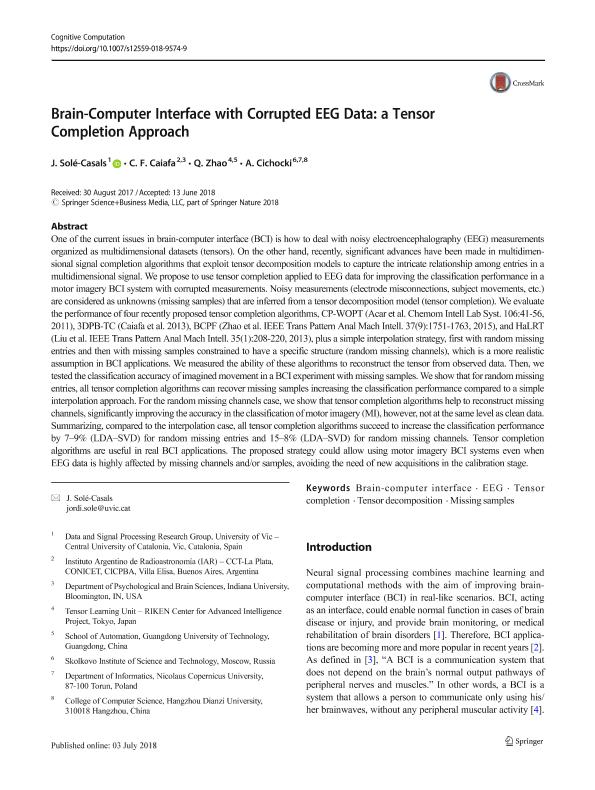Mostrar el registro sencillo del ítem
dc.contributor.author
Solé Casals, J.
dc.contributor.author
Caiafa, César Federico

dc.contributor.author
Zhao, Q.
dc.contributor.author
Cichocki, A.
dc.date.available
2019-08-28T18:52:24Z
dc.date.issued
2018-12
dc.identifier.citation
Solé Casals, J.; Caiafa, César Federico; Zhao, Q.; Cichocki, A.; Brain-Computer Interface with Corrupted EEG Data: a Tensor Completion Approach; Springer; Cognitive Computation; 10; 6; 12-2018; 1062-1074
dc.identifier.issn
1866-9956
dc.identifier.uri
http://hdl.handle.net/11336/82412
dc.description.abstract
One of the current issues in brain-computer interface (BCI) is how to deal with noisy electroencephalography (EEG) measurements organized as multidimensional datasets (tensors). On the other hand, recently, significant advances have been made in multidimensional signal completion algorithms that exploit tensor decomposition models to capture the intricate relationship among entries in a multidimensional signal. We propose to use tensor completion applied to EEG data for improving the classification performance in a motor imagery BCI system with corrupted measurements. Noisy measurements (electrode misconnections, subject movements, etc.) are considered as unknowns (missing samples) that are inferred from a tensor decomposition model (tensor completion). We evaluate the performance of four recently proposed tensor completion algorithms, CP-WOPT (Acar et al. Chemom Intell Lab Syst. 106:41-56, 2011), 3DPB-TC (Caiafa et al. 2013), BCPF (Zhao et al. IEEE Trans Pattern Anal Mach Intell. 37(9):1751-1763, 2015), and HaLRT (Liu et al. IEEE Trans Pattern Anal Mach Intell. 35(1):208-220, 2013), plus a simple interpolation strategy, first with random missing entries and then with missing samples constrained to have a specific structure (random missing channels), which is a more realistic assumption in BCI applications. We measured the ability of these algorithms to reconstruct the tensor from observed data. Then, we tested the classification accuracy of imagined movement in a BCI experiment with missing samples. We show that for random missing entries, all tensor completion algorithms can recover missing samples increasing the classification performance compared to a simple interpolation approach. For the random missing channels case, we show that tensor completion algorithms help to reconstruct missing channels, significantly improving the accuracy in the classification of motor imagery (MI), however, not at the same level as clean data. Summarizing, compared to the interpolation case, all tensor completion algorithms succeed to increase the classification performance by 7–9% (LDA–SVD) for random missing entries and 15–8% (LDA–SVD) for random missing channels. Tensor completion algorithms are useful in real BCI applications. The proposed strategy could allow using motor imagery BCI systems even when EEG data is highly affected by missing channels and/or samples, avoiding the need of new acquisitions in the calibration stage.
dc.format
application/pdf
dc.language.iso
eng
dc.publisher
Springer

dc.rights
info:eu-repo/semantics/openAccess
dc.rights.uri
https://creativecommons.org/licenses/by-nc-sa/2.5/ar/
dc.subject
Brain-Computer Interface
dc.subject
Eeg
dc.subject
Missing Samples
dc.subject
Tensor Completion
dc.subject
Tensor Decomposition
dc.subject.classification
Ciencias de la Computación

dc.subject.classification
Ciencias de la Computación e Información

dc.subject.classification
CIENCIAS NATURALES Y EXACTAS

dc.title
Brain-Computer Interface with Corrupted EEG Data: a Tensor Completion Approach
dc.type
info:eu-repo/semantics/article
dc.type
info:ar-repo/semantics/artículo
dc.type
info:eu-repo/semantics/publishedVersion
dc.date.updated
2019-08-16T16:48:30Z
dc.journal.volume
10
dc.journal.number
6
dc.journal.pagination
1062-1074
dc.journal.pais
Estados Unidos

dc.description.fil
Fil: Solé Casals, J.. Universitat de Vic; España
dc.description.fil
Fil: Caiafa, César Federico. Indiana University; Estados Unidos. Provincia de Buenos Aires. Gobernación. Comisión de Investigaciones Científicas. Instituto Argentino de Radioastronomía. Consejo Nacional de Investigaciones Científicas y Técnicas. Centro Científico Tecnológico Conicet - La Plata. Instituto Argentino de Radioastronomía; Argentina
dc.description.fil
Fil: Zhao, Q.. Guangdong University Of Technology; China. Riken; Japón
dc.description.fil
Fil: Cichocki, A.. Skolkovo Institute Of Science And Technology; Rusia. Hangzhou Dianzi University; China
dc.journal.title
Cognitive Computation
dc.relation.alternativeid
info:eu-repo/semantics/altIdentifier/doi/http://dx.doi.org/10.1007/s12559-018-9574-9
dc.relation.alternativeid
info:eu-repo/semantics/altIdentifier/url/https://link.springer.com/article/10.1007%2Fs12559-018-9574-9
Archivos asociados
